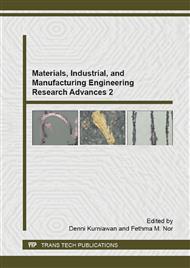p.106
p.111
p.116
p.121
p.126
p.131
p.136
p.143
p.148
Hydrothermal Synthesis Effect on Growth of Zinc Oxide Structure
Abstract:
The properties and performances of Zinc Oxide (ZnO) film have made the material spread widely in several applications such as in providing energy to consumers in which it is harvest energy from the sun rays. By using hydrothermal method in order to fabricate ZnO films is one of the process that consume less energy and lower temperature compare to the other methods. In this research, the seed layer of ZnO was deposited on Fluorine doped Tin Oxide (FTO) substrate and heat treated at 100 °C for 10 min prior to the hydrothermal growth. Hydrothermal growth temperature was varies at 70 °C, 90 °C and 110 °C for 12 hours. The ZnO-coated FTO films were characterized by X-ray diffraction (XRD), scanning electron microscope (SEM) and energy disperse spectroscopy (EDS). The I-V characteristic of the ZnO-coated FTO films was characterized with solar simulator. The experimental results reveal that the hydrothermal growth temperature exerts a strong influence on the properties of the ZnO-coated FTO films. The effects of the hydrothermal growth temperature are discussed.
Info:
Periodical:
Pages:
126-130
Citation:
Online since:
October 2015
Keywords:
Price:
Сopyright:
© 2015 Trans Tech Publications Ltd. All Rights Reserved
Share:
Citation:


